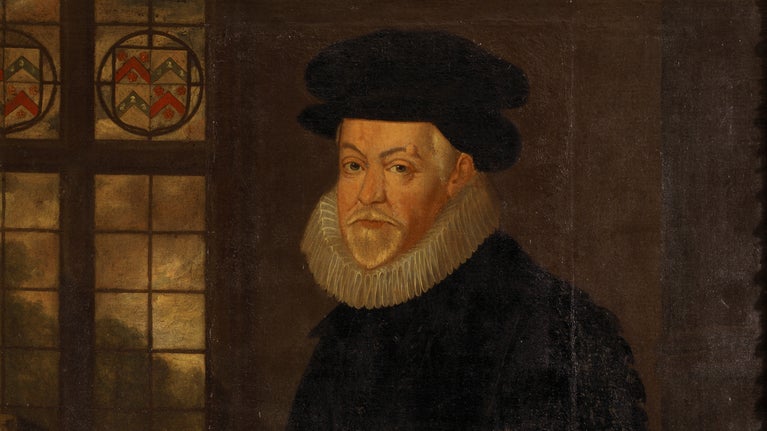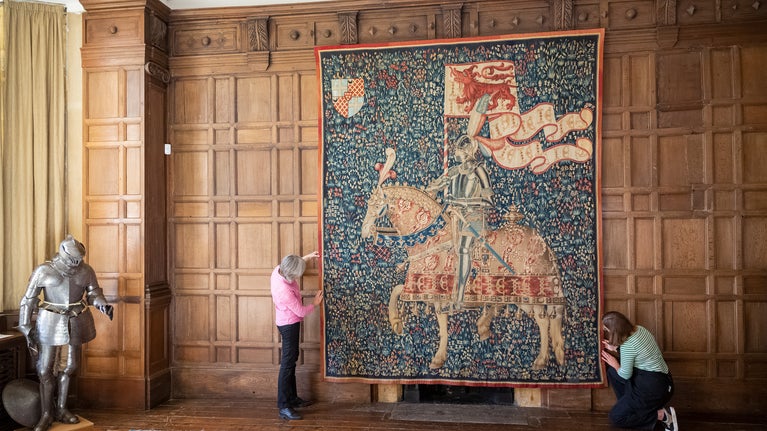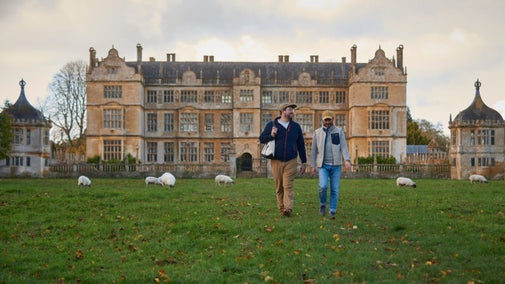
Discover more at Montacute House
Find out when Montacute House is open, how to get here, the things to see and do and more.

Montacute House, Somerset, is an Elizabethan ‘prodigy house’ or ostentatious mansion, commissioned by the ambitious courtier, Sir Edward Phelips (c. 1554–1614). It remained in the Phelips family until the 20th century when it was acquired and furnished by the National Trust.
Montacute House and the adjacent village belong to a landscape with evidence of settlement going back to prehistoric times. One of the largest hillforts in Britain dating to the Iron Age (c. 800 BCE–43 CE) lies 1.2 miles to the west at Ham Hill and what is thought to be a Roman road crosses the park. The honey-coloured Ham stone of which Montacute is built was quarried from the site of the hillfort.
The name ‘Montacute’ is derived from mons acutus, Latin for ‘steep hill’. The conical formation from which the village takes its name is known as St Michael’s Hill, and is situated in the park, close to the house. A miraculous cross is said to have been discovered there in the early 11th century and taken to Waltham Abbey in Essex as a holy relic.
A few decades later, a castle was built on the hill by Robert, Count of Mortain (c. 1031–c. 1095), half-brother of the Norman king, William the Conqueror, desecrating what was regarded as a sacred place. Local people rose up in anger, but the rebellion was crushed. The settlement beneath the hill was then known as Bishopston and for over 400 years a large Cluniac priory (a small monastery under the supervision of Cluny Abbey in France) flourished there.

During this period, many people in Somerset relied on the prosperous wool and cloth trades, including the Phelips family, who came to live in Montacute in the late 15th century. Richard Phelips (c. 1480–1558) raised his family’s status by becoming a member of Parliament in 1512.
The most ambitious and able of Richard’s grandsons was Sir Edward Phelips (c. 1554–1614). He was a successful lawyer, representing aristocratic clients and dealing with property disputes in the High Court in London. He was first elected to Parliament for the pocket borough of Berle Alston, which was in the gift of one of his aristocratic connections, in 1584.
Although he was the youngest son, in 1588 Edward inherited the best part of his father’s sizeable fortune, adding to the wealth he had already accumulated himself. He immediately commissioned the construction of Montacute House, probably from the Somerset master mason (or architect-builder) William Arnold.
Stones from the nearby priory, abandoned when King Henry VIII ordered the dissolution of the monasteries in the late 1530s, were embedded in the new Montacute House which became the dominant building in the area. With its symmetrical exterior and large, expensive glass windows, it was highly contemporary and sophisticated, with continental architectural touches signifying the worldly outlook of its owner.
So-called ‘prodigy houses’ like Montacute were built by people of ambition in order to win favour at Court and in the hope of being asked to host a royal visit. Edward succeeded in this at first. Buying a knighthood from King James I, he gained prestigious appointments in royal service, including Speaker of the House of Commons, Chancellor of the Duchy of Cornwall (a position in the household of the Prince of Wales) and Master of the Rolls (a lucrative legal post).
As an assize (or regional) court judge, Edward was known for his severe treatment of Catholics who refused to convert to the dominant Anglican faith. In 1606 he opened proceedings against the conspirators in the Gunpowder Plot, a group of Catholics who had tried to blow up the House of Lords and kill James I.
Edward was never particularly popular, however, and eventually the king wearied of him. He had overspent to support his ambitions and his speculation in the shares of the Virginia Company, set up to develop the English colony in Jamestown, Virginia, ended in failure. He died a disappointed man, passing his debts to his son Robert, from his first marriage to Margaret Newdegate (1564–90). Sir Robert Phelips (1586–1638) lived well, furnished Montacute House extravagantly and sank even further into debt. He was forced to give the house to his elder son Edward Phelips (1613–80), so that his debts would be paid by Sir Robert Pye, father of his daughter-in-law Anne Pye.
Robert opposed both James I and Charles I on various issues and was temporarily imprisoned in the Tower of London in 1622. In spite of this his two sons became royalist colonels during the British Civil Wars (1642–51). One reputedly sold the family tapestries to raise money for the King, while the other helped the Prince of Wales (later King Charles II) escape to France after the battle of Worcester in 1651.

The family finances remained uncertain until the time of Robert’s four-times great-grandson, Edward Phelips V (1725–97), who benefitted from two substantial inheritances. This enabled him to extend the west front of Montacute House reusing ornamental stonework brought from Clifton Maybank, a mid-16th-century house in Dorset that was being demolished. Edward V also switched the main entrance to the house from east to west, constructed a new west drive and made alterations to the park in the fashionable picturesque style.
Much of Edward V’s work at Montacute House was later overlaid by that of William Phelips (1823–89) and his wife Ellen Helyar (1816–1911). Ellen brought a large dowry, much of which was spent on modifications, mostly now evident in the park. They, like Edward, seem to have respected the Elizabethan architecture of Montacute, in which there was by then a revival of interest.
By the early 20th century, the Phelips family was again in financial difficulty and the house was let. The longest-lasting tenant was George Nathaniel Curzon, 1st Marquess Curzon of Kedleston (1859–1925), a cabinet minister and former Viceroy, ruling the subcontinent on behalf of the British Crown. George restored and adapted the shabby interiors at Montacute, most of the work being overseen by the novelist and film scriptwriter Elinor Glyn (1864–1943), with whom he was in a relationship.

In 1931, again empty, the house was nearly sold for scrap. It was bought by the philanthropist Ernest Cook (1865–1955) on behalf of the Society for the Protection of Ancient Buildings (SPAB), who later presented it to the National Trust.
During the period of National Trust ownership the interiors of Montacute have been filled with bequests, gifts and loans. It now contains some internationally-significant collections, including a rare 15th-century Flemish tapestry (the earliest held by the National Trust) depicting a knight on horseback, bequeathed by Sir Malcom Stewart (1872–1951), the Dr Douglas Goodhart collection of samplers donated in 1987 and a significant suite of early 18th-century parcel gilt furniture from Chicheley Hall in Buckinghamshire, accepted in lieu of inheritance tax and allocated to Montacute in 2012.
Nicholas Cooper and Jo Moore, Montacute House, Swindon, National Trust, 2018
Julian Orbach and Nikolaus Pevsner, Somerset: South and West, New Haven and London, Yale University Press (The Buildings of England series), 2014
Thomas G. Barnes, ‘Phelips, Sir Robert (1586?–1638), politician and landowner’, Oxford Dictionary of National Biography, 2008 https://www.oxforddnb.com/view/10.1093/ref:odnb/9780198614128.001.0001/odnb-9780198614128-e-22090 (accessed 13 October 2025)
Alan Kittermaster, ‘Sir Edward Phelips (c.1554-1614)’, Notes and Queries for Somerset and Dorset https://www.sdnq.org.uk/spotlight_on_sdnq/sir-edward-phelips-c-1554-1614/ (accessed 13 October 2025)
Rebecca S. More, ‘Phelips, Sir Edward (c. 1555–1614), speaker of the House of Commons’, Oxford Dictionary of National Biography, 2008 https://www.oxforddnb.com/view/10.1093/ref:odnb/9780198614128.001.0001/odnb-9780198614128-e-22089 (accessed 13 October 2025)

Find out when Montacute House is open, how to get here, the things to see and do and more.
Explore the ground floor of the house at Montacute in Somerset, home of the rare Tournai Tapestry.

Walk the estate at Montacute House and discover nature, views and landmarks to enjoy throughout the season. Bring along your dog and enjoy wide-open spaces.

Learn about people from the past, discover remarkable works of art and brush up on your knowledge of architecture and gardens.

Explore the objects and works of art we care for at Montacute House on the National Trust Collections website.
